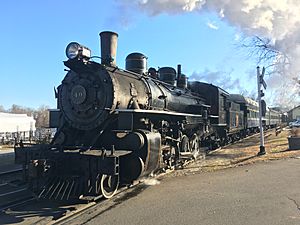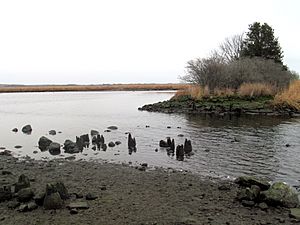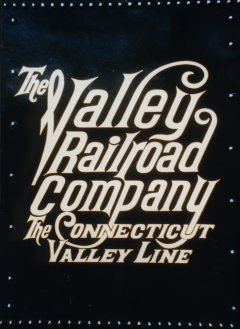Valley Railroad (Connecticut) facts for kids

Valley Railroad #40 at Deep River in December 2018
|
|
| Overview | |
|---|---|
| Headquarters | Essex, Connecticut |
| Reporting mark | VALE |
| Locale | Middlesex County, Connecticut |
| Dates of operation | July 29, 1871 – March 30, 1968 July 29, 1971–present |
| Predecessor | New York, New Haven and Hartford Railroad Penn Central Transportation Company |
| Technical | |
| Track gauge | 1,435 mm (4 ft 8 1⁄2 in) standard gauge |
| Length | 21.67 miles (34.87 km) |
The Valley Railroad is a special kind of train line in Connecticut. It's called a heritage railroad because it uses old tracks and trains to show what train travel was like in the past. This railroad runs the famous Essex Steam Train and the Essex Clipper Dinner Train. It's built on the tracks of the original Connecticut Valley Railroad, which started way back in 1868.
History of the Valley Railroad
Building the First Railroad
The idea for the Valley Railroad began in the 1840s. A man named James Clark Walkley and his friend Horace Johnson explored the area. They wanted to build a railroad line that was about 44 miles long.
In 1868, Walkley and other business people got permission to create the Connecticut Valley Railroad Company. They started planning to build the railroad. From 1868 to 1869, teams surveyed the land. They mapped out the route from Hartford, Connecticut to Saybrook Point.
Construction started in April 1870 in Higganum, Connecticut. The plan was to build the line in three parts. The "Northern Division" went from Hartford to Middletown. The "Middle Division" continued to a place now called Goodspeed Landing. The "South Division" finished the line to Saybrook Point. Building the railroad in the Connecticut River Valley was easy. They didn't need any tunnels or big bridges. The whole line was finished by the summer of 1871. The first special train ran on July 29, 1871. It traveled the 45 miles (72 km) at about 22 miles per hour. The railroad cost about $1.5 million to build.
The Original Connecticut Valley Railroad
The first regular train service began on July 31, 1871. The Connecticut Valley Railroad officially opened on August 24, 1871. Trains ran daily, except Sundays. There was one mixed train (carrying both passengers and goods) and four passenger trains each way. They made fifteen stops along the route.
In its first year, the company earned $34,000. By 1873, it was earning $250,000 a year. But many early railroads faced money problems. The Connecticut Valley Railroad had financial trouble in 1876. It went into a special legal process called receivership.
Hartford & Connecticut Valley Railroad Takes Over
On July 1, 1880, a new company took control. It was called the Hartford and Connecticut Valley Railroad. Samuel Babcock became its president.
Over time, passenger train service slowly stopped. It ended between Saybrook Point and Fenwick in 1917. Then between Fenwick and Saybrook Junction in 1922. Service between Saybrook Junction and Middletown stopped around 1929 or 1930. Finally, passenger trains between Middletown and Hartford ended in 1933.
The Valley Railroad Company Today
From 1961 to 1968, the Valley Line was used less and less. It was down to just one freight train a week. The railroad company went bankrupt in 1961. The Valley Line was officially closed on March 30, 1968. This happened just before the railroad merged into Penn Central. Penn Central wanted to get rid of the Valley Line completely.
But the Connecticut Valley Railroad Association (CVRA) saved it. They were worried the tracks would be torn up. The CVRA, the Empire State Railway Museum, and other investors created today's Valley Railroad. They got a special permission from the state of Connecticut. The State of Connecticut then bought the line from Penn Central. It made the Valley Line a State Park.
The railroad reopened on July 29, 1971. This was exactly 100 years after the first train ran on the original line. The first train on the new Valley Railroad ran between Essex and Deep River. Later, the train line was extended to Chester in the late 1970s. Special "Saybrook Special" trains started running in the early 1980s. These trains connected with Amtrak at the Old Saybrook station for one year. The special and dinner trains were extended to Haddam in 1993. They reached Goodspeed in the late 1990s and early 2000s. In 2017, the dinner train went even further north of Goodspeed. However, trains beyond Goodspeed were stopped in 2019. Now, railbikes are used there instead.
Trains and Cars
The Valley Railroad has many different types of trains and cars. They use both steam locomotives and diesel engines. They also have special passenger cars for different trips.
Steam Locomotives
These are the classic trains that run on steam power.
Diesel Engines
These engines run on diesel fuel. They are used for various tasks, including pulling dinner trains.
Passenger Cars
The railroad has many different passenger cars for its trips. Some are very old and have been restored.
Railroad Facilities
The Tracks
The Valley Railroad Company uses tracks that are leased from the Connecticut Department of Energy and Environmental Protection. These tracks run from Old Saybrook through Essex, Deep River, Chester, Haddam, and Middletown. This is a total of 21.67 miles (34.87 km) of track.
The tracks are built on gravel. They use wooden ties and steel rails. In 2015, a big project improved the main tracks from Essex to North Chester. They now have stone ballast, which makes them stronger. The Valley Railroad tracks connect with Amtrak's Northeast Corridor tracks near the Old Saybrook Station. About 14.25 miles of the line are currently used for train service. The rest of the line last saw service in 1968. The part of the track between Haddam and Middletown is being worked on. It is being cleared and maintained. The goal is to fully restore it when there is enough time and money.
The Valley Railroad has several places where the tracks cross roads. These are called grade crossings. Some are small private crossings with caution signs. Others are public crossings with flashing lights, bells, and gates. The busiest public crossings are in Essex on Route 153 and Route 154. Another busy one is on Route 82 in Haddam.
Train Stations
The main station for the Valley Railroad is in Essex. This is where you buy tickets. All the trains and cars are also kept here. The main entrance is off Route 154.
There is also a station building in Deep River. It is used as offices for the riverboat tours. In Chester, there is a small station. The railroad's track department uses it. This building was originally the station in Quinnipiac, Connecticut.
The Goodspeed station is in Haddam. It has an antique shop and is not part of the railroad. Across the tracks is the Goodspeed Yard Office. This building was the original Chester passenger station from 1871. It was moved to its current spot in 1993. It is believed to be the only original passenger station left from when the railroad first opened.
In 2009, a new passenger shelter was built in Chester. It looks like the old South Britain station. This new building is on the site of the original Hadlyme station. Passengers use this station today to go to Gillette Castle State Park. They can take the Chester-Hadlyme Ferry, which is one of the oldest ferries in the United States.
Images for kids

































